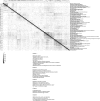The Diagnosis-Wide Landscape of Hospital-Acquired AKI
- PMID: 28495862
- PMCID: PMC5460713
- DOI: 10.2215/CJN.10981016
The Diagnosis-Wide Landscape of Hospital-Acquired AKI
Abstract
Background and objectives: The exploration of electronic hospital records offers a unique opportunity to describe in-depth the prevalence of conditions associated with diagnoses at an unprecedented level of comprehensiveness. We used a diagnosis-wide approach, adapted from phenome-wide association studies (PheWAS), to perform an exhaustive analysis of all diagnoses associated with hospital-acquired AKI (HA-AKI) in a French urban tertiary academic hospital over a period of 10 years.
Design, setting, participants, & measurements: We retrospectively extracted all diagnoses from an i2b2 (Informatics for Integrating Biology and the Bedside) clinical data warehouse for patients who stayed in this hospital between 2006 and 2015 and had at least two plasma creatinine measurements performed during the first week of their stay. We then analyzed the association between HA-AKI and each International Classification of Diseases (ICD)-10 diagnostic category to draw a comprehensive picture of diagnoses associated with AKI. Hospital stays for 126,736 unique individuals were extracted.
Results: Hemodynamic impairment and surgical procedures are the main factors associated with HA-AKI and five clusters of diagnoses were identified: sepsis, heart diseases, polytrauma, liver disease, and cardiovascular surgery. The ICD-10 code corresponding to AKI (N17) was recorded in 30% of the cases with HA-AKI identified, and in this situation, 20% of the diagnoses associated with HA-AKI corresponded to kidney diseases such as tubulointerstitial nephritis, necrotizing vasculitis, or myeloma cast nephropathy. Codes associated with HA-AKI that demonstrated the greatest increase in prevalence with time were related to influenza, polytrauma, and surgery of neoplasms of the genitourinary system.
Conclusions: Our approach, derived from PheWAS, is a valuable way to comprehensively identify and classify all of the diagnoses and clusters of diagnoses associated with HA-AKI. Our analysis delivers insights into how diagnoses associated with HA-AKI evolved over time. On the basis of ICD-10 codes, HA-AKI appears largely underestimated in this academic hospital.
Keywords: Acute Kidney Injury; Heart Diseases; Hemodynamics; Hospital Records; Humans; Influenza, Human; International Classification of Diseases; Length of Stay; Liver Diseases; Multiple Trauma; Neoplasms; Nephritis, Interstitial; Prevalence; Retrospective Studies; Sepsis; Urogenital System; acute renal failure; clinical nephrology; creatinine; hospitalization; vasculitis.
Copyright © 2017 by the American Society of Nephrology.
Figures




References
-
- Chertow GM, Burdick E, Honour M, Bonventre JV, Bates DW: Acute kidney injury, mortality, length of stay, and costs in hospitalized patients. J Am Soc Nephrol 16: 3365–3370, 2005 - PubMed
-
- Selby NM, Crowley L, Fluck RJ, McIntyre CW, Monaghan J, Lawson N, Kolhe NV: Use of electronic results reporting to diagnose and monitor AKI in hospitalized patients. Clin J Am Soc Nephrol 7: 533–540, 2012 - PubMed
-
- Tenenbaum JD, Avillach P, Benham-Hutchins M, Breitenstein MK, Crowgey EL, Hoffman MA, Jiang X, Madhavan S, Mattison JE, Nagarajan R, Ray B, Shin D, Visweswaran S, Zhao Z, Freimuth RR: An informatics research agenda to support precision medicine: Seven key areas. J Am Med Inform Assoc 23: 791–795, 2016 - PMC - PubMed
MeSH terms
Substances
LinkOut - more resources
Full Text Sources
Other Literature Sources
Medical
Miscellaneous

